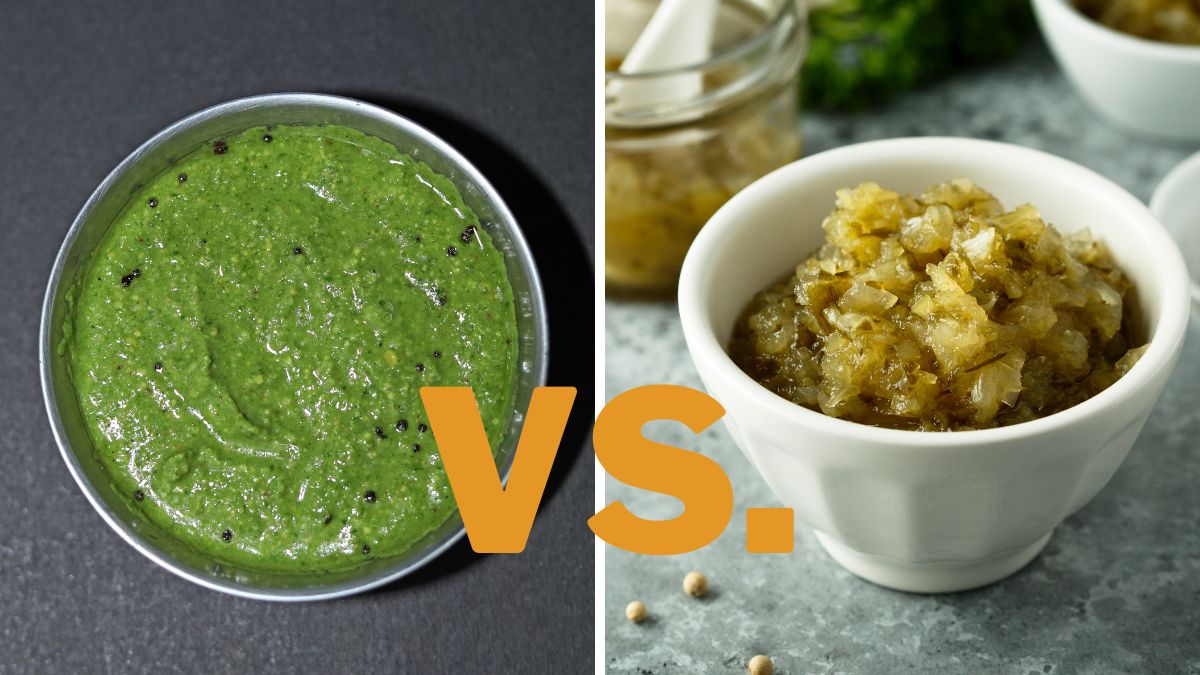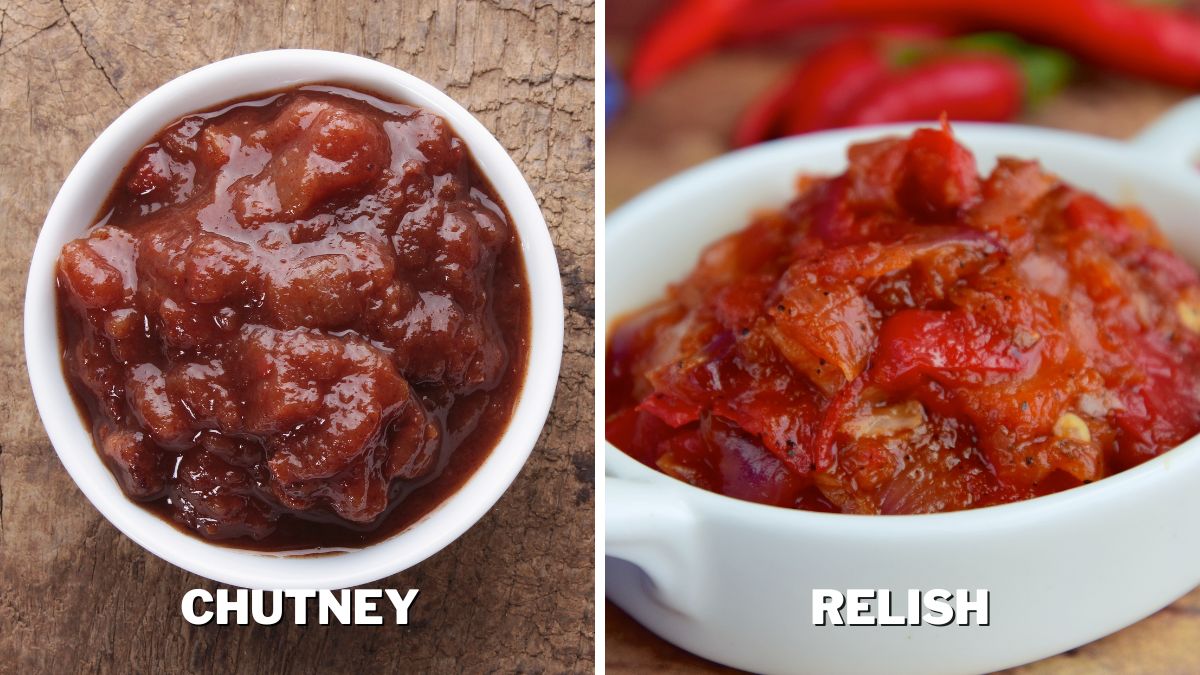Chutney vs. Relish: Differences & Uses

Whenever you want to turn an ordinary dish into an extraordinary one, you should reach either for chutney or relish. And even though I often use them both, there are some cases where one of them is the clear winner. Even the dullest dish will spring to life with a small amount of either. They may seem similar, but chutney and relish are definitely not the same. So, what are the differences between chutney and relish?
Chutney is a thick and chunky condiment made by cooking a combination of fruits, vegetables, herbs, spices, vinegar, and sugar. Relish is a finely chopped or diced condiment made by mixing chopped vegetables, vinegar, sugar, and spices without cooking.
Chutney and relish are equal members of my menu, and I use and love both condiments. Still, just because they are similar doesn’t mean that it doesn’t matter which one you choose. In this article, I will explain the differences between chutney and relish and help you make the right decision next time you are in a pickle.
Ingredients and Preparation
Chutney is a condiment that comes from the Indian subcontinent. If you know anything about Indian food, the sheer fact that it has an Indian origin should tell you a lot about chutney. It follows the traditional Indian cooking method and ingredients.
It is made by grinding together a combination of fruits or vegetables, herbs, spices, vinegar, and sugar. The technique itself, though, is not unique to India only, as many cultures use a similar procedure for fermenting food, but the taste definitely is.
After grinding, the ingredients are cooked to create a thick and chunky consistency. I love chutney because it is easy to make and is uniquely delicious. You can make your chutneys sweet, spicy, or a little bit of both, depending on what you prefer.
The cooking method and the ingredients definitely offer a wide range of experimentation possibilities. Even though there is no precise recipe to follow, chutneys often contain ingredients like mango, tomato, coconut, tamarind powder, cilantro, mint, ginger, and various spices.
Relish, on the other hand, is a condiment that is popular in Western cuisine, so you may find its flavor more palatable. Since there is no precise definition confining what relish is in a firm frame, you can consider it as something you put on your food to make it more fun. So, by this definition, chutney would be a kind of relish.
Still, the relish we are used to has a specific flavor and often contains specific ingredients, though you can make it with whatever you want as long as you follow the making process. Relish is typically made by chopping or finely dicing vegetables, such as cucumbers, onions, peppers, and pickles, and this is probably the biggest difference between the two.
After chopping, the ingredients are mixed with vinegar, sugar, and various spices, just like for chutney. Still, unlike chutney, relish is usually not cooked, and the vegetables retain their crunchiness, while for chutney they have to undergo thermal processing.
Another difference is that relishes can be sweet or savory, depending on the recipe and the intended use.
Texture and Appearance
Since chutney ingredients are ground together, the resulting texture is thick and chunky. Sometimes, though, chutney can be paste-like depending on the ingredients, as not all ingredients look the same when ground. Sometimes, I am too impatient to grind the ingredients thoroughly, and I end up with a chunkier chutney, while other times, I am very detail-oriented and make a smooth one.
No matter the ingredients, you can always expect chutney to be smooth and soft, which is why I often use it as a dip. As for the texture, I prefer it more paste-like with the occasional fruit or vegetable chunk.
The ingredients dictate the color of the chutney, so you can find chutneys with vibrant green shades, deep red, or golden brown, depending on what they are made of. I find chutneys more exotic in appearance, and I tend to combine them with traditional Indian foods, but a good old chicken and rice is also a great way to pair chutney.
Relishes have a more finely chopped or diced texture than chutneys. They aren’t as chunky, though sometimes a relish can be coarser than chutney if the chutney has been ground more than usual. Still, the general rule stands.
What makes relish different is the mechanical processing, i.e., chopping instead of grinding, and the fact that the vegetables are uncooked. However, the relish veggies not being cooked doesn’t mean that they haven’t been processed because the vinegar and sugar definitely trigger mild fermentation. Still, the veggies in relish remain crispy.
Relishes usually have a uniform texture with small, evenly distributed pieces of vegetables. They are often brightly colored, and just like chutney, they vary from green to red to brownish or yellowish.
Uses

The sky is the limit when it comes to using chutney and relish. Both are very versatile, and their uses are totally up to you.
As a general guideline, though, chutneys are a staple in Indian cuisine and are often served as a side dish or condiment alongside main courses, such as curry, biryani, or dosa. You can also use chutney as a spread in sandwiches or wraps to add flavor and moisture, which is what I do.
You can use chutney with grilled meats to enhance their taste, fish to tone down the fishy notes, or vegetables, to add a little zing to them. Sweet chutneys make delicious toppings for desserts, like ice cream or cakes.
Relishes are usually used as toppings for savory dishes. They are more commonly used than chutney in the Western world because they are more familiar to the Western palate. You can use relish the same way you use chutney, so with grilled foods, burgers, hot dogs, sausages, or barbecued meats.
The crunchy texture and tangy flavor of relish are also a great addition to home-cooked dishes, such as roasts with veggies. I also love it in sandwiches, salads, wraps, or as a condiment for cheese or charcuterie boards.
Variations
Since both chutney and relish can be made with various ingredients and spices, they come in as many variations as you want. You can make sweet or savory chutney or relish it with different spices and flavorings, from the classic salt and pepper to more complex ones like cumin or cinnamon or fennel seeds.
The one I use the most is the sweet chutney, and I love them in meat glazes! What about you? Tell me all about your favorite way to use chutney and relish in the comments below!
